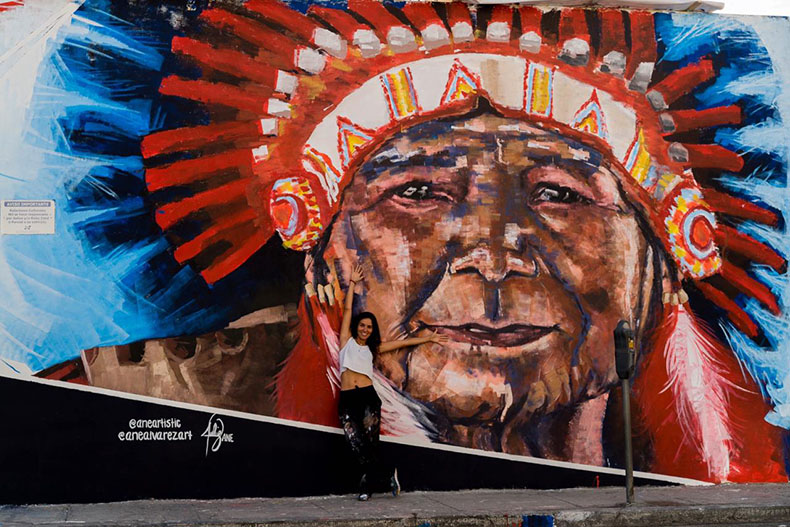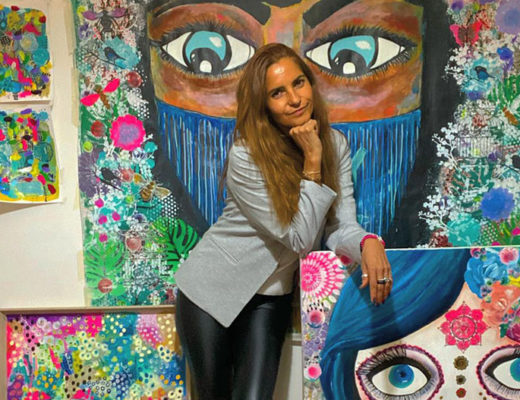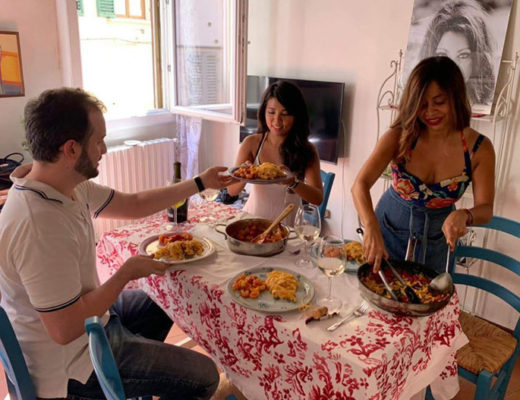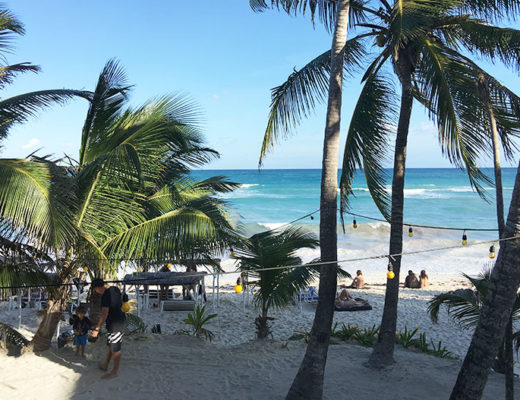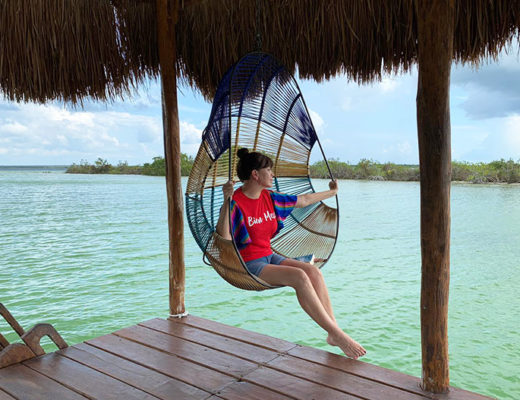Since 1920, muralism has formed an essential part in the history of Mexican art. Great artists captured the reality of their time on walls, immortalizing historical figures, revealing political changes, social inequalities, the roots of a nation and events of global impact. A type of art that has always been available to all the people.
Over the years, muralism has changed and now, a century later, it is still a form of expression. In fact, in many cities around the world, urban art is being used to transform vulnerable areas.
However, many still associate urban art mainly with male artists, but there are already many women who are leaving their mark in the world, such as Mexican artist Ane Alvarez, who lives in Cancun and has painted her murals in Mexico and in different countries such as Finland, Spain, Germany, Italy and Austria. She recently won an award in Italy, being the only woman -out of six winners- who will be able to paint in Sardinia.
As I love urban art and especially stories of women who follow their dreams, I had to interview and share Ane’s story on this blog.
How did you start your career in urban muralism?
I started by coincidence, without thinking that I was going to do murals. I have been painting for about 5 years and started with canvases. At first, I studied Plastic Arts, but only for six months, then I changed my career. After I graduated in Fashion Design, I started looking for work, but I realized that it was not what I liked, what I really wanted. Then I started to paint and dedicate myself to Plastic Arts again but on my own. In Cancun, a friend had a restaurant that he was remodeling and he said to me ‘hey, I have a white wall, why don’t you paint something for me’ and I told him that I have no experience painting murals and he said ‘it doesn’t matter, no worries, go ahead, you have the wall to do what you want’. So that is how I started, daring to make the mural more or less like I believed.
I learned a lot by making this mural because working large is different than working small and the surface is also different. After that, as I am very active on social media and follow some muralists, I started talking to a Mexican artist who lives in Canada and it turned out that this artist manages international art festivals. He saw my mural and liked it, and invited me to the next edition of festivals that he was going to do. From little things bigger things came up.
Is it difficult for a woman to enter the world of urban art?
Actually yes, I think, there are more known male muralists than female; even though there are many women who are in fact very good. But one of the interesting things that I have experienced as a female muralist is that, for example, when I am working on a wall -it happens a lot here in Mexico-, I am painting on the street, in an open place where people pass by and see you, naturally people come to see what you are doing, they ask you things, sometimes they even say ‘hey, can I help you?’, but one of the curious things that happen to me is that if a man is next to me, either because he is watching or helping, people automatically think that the project belongs to the man, not to me.
Even though I have the brush in my hand and am painting, they approach the guy and ask him ‘hey, is it yours?’, ‘how much do you charge?’ or whatever, but as if I were his assistant. That does happen a lot to me and it is frustrating because they automatically associate the leader, the project owner or the person in charge with the male role. But whenever this happens to me, I go up to the person and try to explain that I am the one doing it, why couldn’t I do it?
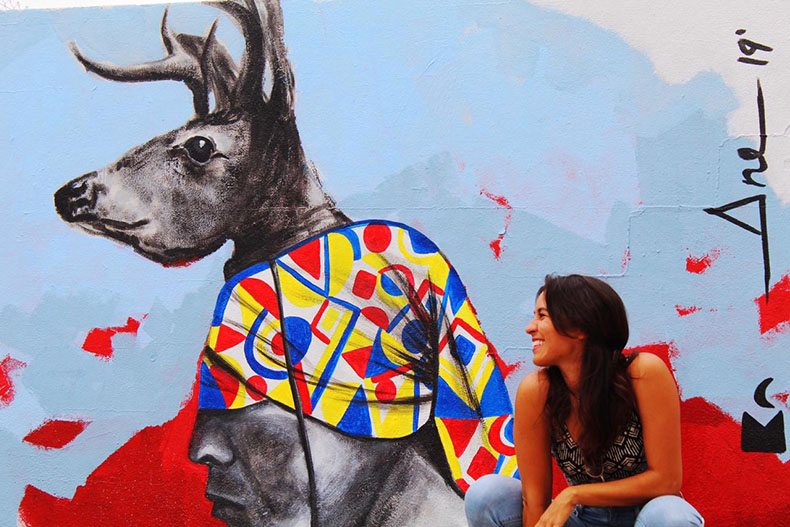
Today there is this worldwide trend of rehabilitating abandoned or vulnerable areas and transforming them through urban art, where personalities are honored, used as social criticism or to bring positive messages to the community. What is the message you want to transmit with your art?
I really like working with Mexican cultures and traditions. Highlight the values of tribes that one does not know much about or something of cultural value about Mexico. When I do it in Mexico, I like to do it that way, for example in Monterrey, I painted a mural of an Indian from the Kickapoo tribe. The idea was to highlight a quality of the culture of Monterrey or Northern Mexico, but when I did all the research and noticed that there was not much documentation of the native tribes of Northern Mexico, I investigated a little more and realized that many of the traditions that are known as norteñas or regias -hats, suede pants, dried meat- come from Native American tribes (Comanches, Apaches, Kickapoos).
The Kickapoos are one of the few tribes that have dual citizenship of the United States and Mexico; most of them live in the United States, but as they have ceremonial centers in Coahuila, they have free passage between the two nations. It seemed super interesting to me, because you unite two neighboring countries with a culture that we do not know or at least is not so documented in the history books. So I painted this mural to make people wonder why I put an Indian who is normally associated with Canada or the United States, but not with Mexico. It is not native Mexican but it is part of the Mexican culture that we all know.
Everything we know as norteño has its roots like this, for example dried meat; the Apache, Comanche and other tribes dried their meat and as they were nomads, they carried it around as it was easier to eat it that way, hence the roots. As such, the machaca as we know it today, is so Mexican, but it really comes from there.
When I go abroad, I like to do the same but with cultural things from that specific country, as a tribute to the country I am visiting. For example, in Naples I painted Sophia Loren who is an icon of Italian culture. In Finland, I painted two Finnish film stars from the 1930s-1940s so that people would identify with them. I can do something Mexican and it will attract attention but it will be a bit alien to their culture, therefore I like to bring a bit of Mexico but also highlight the culture of where they are receiving me.
Maybe add some Mexican elements. For example in Germany, I created a mix of cultures that I painted for a Mexican tortilla shop. I painted the port of Hamburg, which is very famous, with which people identify a lot, but I put Mexican elements in it such as a piñata, a trajinera, papel picado. It was very interesting because I mixed both cultures and the Germans identified with the port and the ships and they asked ‘what is that?’ with the piñata, ‘what elements are those that we don’t know about?’
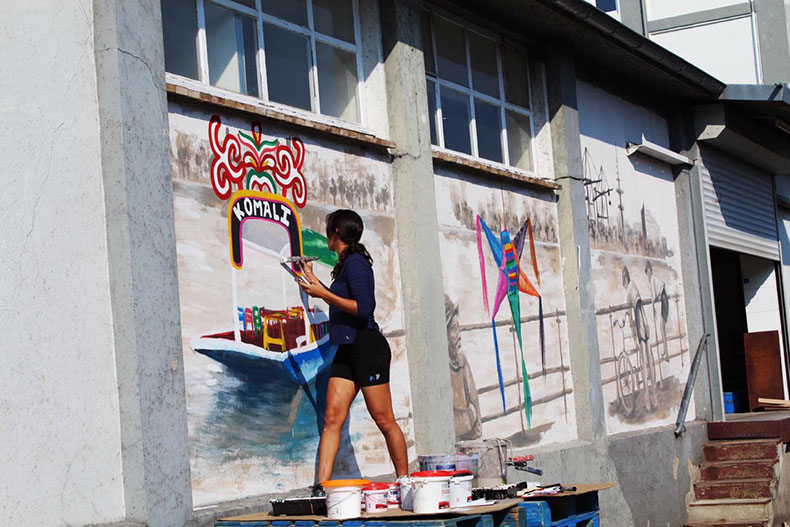
And how is the process, do you choose the city and space where you are going to paint and from there start procedures?
A bit of everything, when I started to leave Mexico to paint, I said to myself ‘I want to go out, I want to paint somewhere else and figure out how to do it’, so I put together a whole project for the countries I wanted to go to and started looking for sponsors, but it didn’t work. I contacted embassies, foundations, paint sponsors, everything. It didn’t work for me, but it gave me the opportunity to open doors and see where I could go. For example in Finland, I found an art festival and wrote to them and they replied ‘you know what, we do want to because we have this project, but the only thing we cannot help you with is the plane ticket, if you can find a way to come, we will help you once you are here and arrange everything for you’. I said to myself if it is only the flight, then I will see how I manage it.
From there everything lined up. Then a friend who has a tortilla factory in Germany called me and said ‘hey Ane, I saw that you are going to be here -because obviously if I crossed over to Europe, I was going to stay longer-, I am opening a new factory and I want you to paint something outside’. And then another artist who I only knew through social media, told me ‘I am in Austria and I am going to work on a project, why don’t you come here and help me’. In Spain, I have family and a friend who is an illustrator and we collaborated together on another project. I love Italy, I went there and from the communities that are organized between neighbors, they hired me to make a mural for a neighborhood and that is how things evolved.
So the projects that I get, is because I look for them through art festivals, calls or people call me, either from private companies or government initiatives. It depends, at least in Mexico more private companies are calling me. For example in Monterrey, the last mural I did was for the “Instituto Municipal de las Mujeres Regias”.
I think the most important thing is that you move around and start doing things for yourself and then people get to know you and call you more.
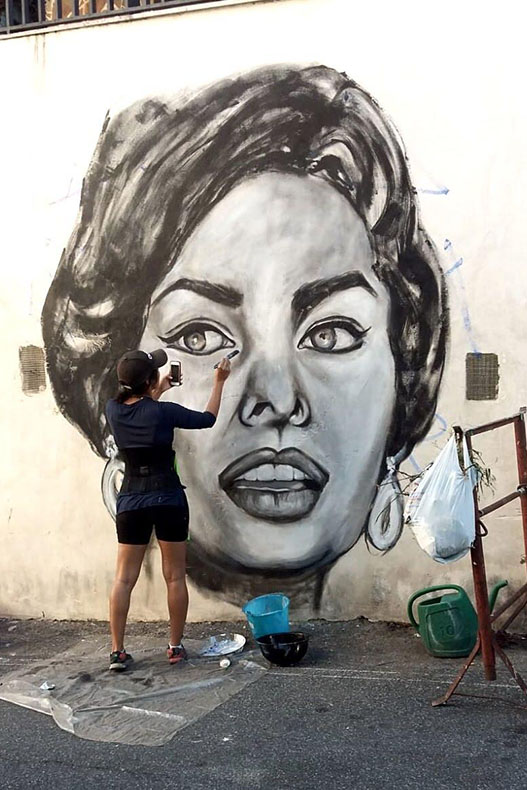
What is the strongest challenge you have faced to be able to paint a mural?
In technical terms, the most difficult was the one in Monterrey, that of the Kikapú man, because it was the second mural of my entire life and the largest I have done. It is the one that I liked the most. It was a big challenge because I didn’t have much experience and it was also the one where I learned the most. It was during the festival to which the event manager (that I mentioned earlier) invited me. We were 20 artists from all over the world, Canadians, Brazilians, South Africans, Italians and I was able to learn a lot from each one. It was like a crash course in muralism for me. If the others hadn’t been there, I think that I wouldn’t have been able to do the mural like I did, because in the process I was learning from each one. It was the biggest challenge and learning experience too.
How long did it take for example to make that mural you are talking about (the one in the main photo of this article)?
Between 10 and 15 days.
As a traveler, what have been your favorite places to paint, the ones that have inspired you the most?
The country I like the most -after Mexico obviously- is Italy, because of the art, the people, the landscapes, the sea. The most beautiful places are Naples, Rome, the important Italian cities. After Italy, I really like Spain. Well, speaking of travel, because I have traveled a lot not only with art, I love to travel, since I was little my parents took us on a trip whenever they could.
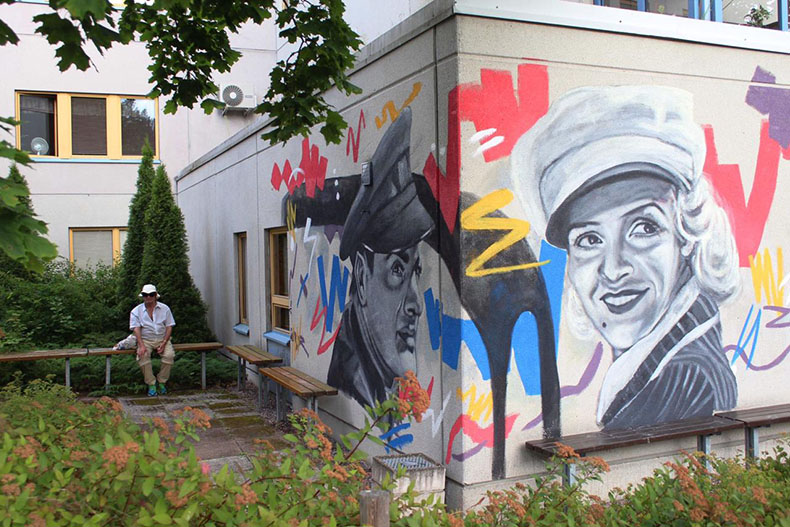
What is your dream? Where would you like to paint?
I would like to paint where I have not painted yet and where I do not know the place. In Greece because I like it a lot and in Asia because I don’t know it and it attracts my attention. For example, in March I was going to go to Australia for a while and from there jump to Thailand, Vietnam, the Philippines, all that, but unfortunately because of Covid-19, it was not possible. It is still on pause.
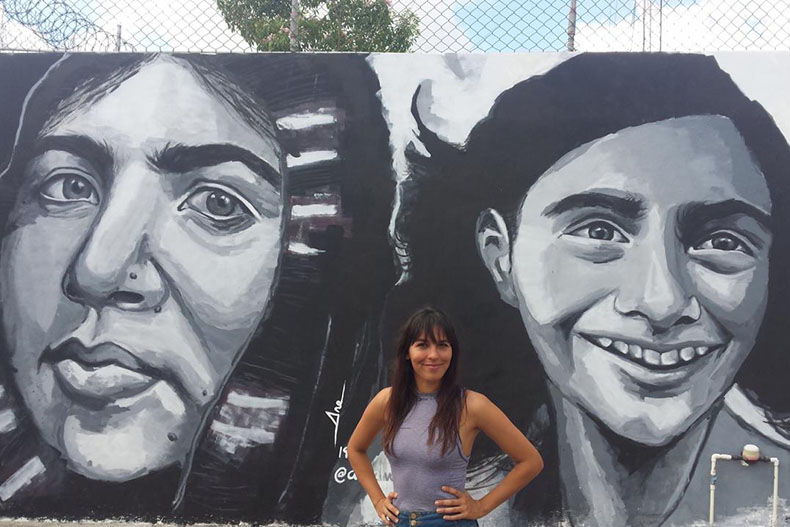
And speaking of dreams, to conclude, as an artist and a woman, you inspire many, what message can you send them to go after their dreams, no matter how complex they may be.
I would tell them to believe in themselves, not to be limited by ideas that we have as a society, which normally are more limited towards women -at least in Mexico-; in other words, “you have a role and you have to follow it because it is your turn”. I would tell them not to be afraid to question that role. If you have a dream, let it be something you genuinely want to do, not because someone told you to do it. I always think that all the concerns we have, although it seems that they are not connected, they really are, maybe right now you don’t understand why something is calling your attention, but maybe in the end it is connected with your life goal or with your mission in life. Everything that makes your inner self, your passions, vibrate, is calling you, for something they are knocking on your door. I would tell them to listen and dare to follow what they like.
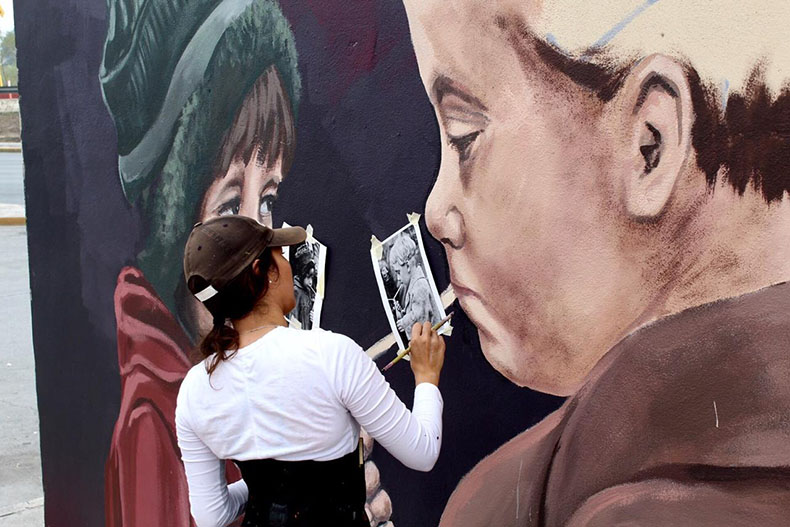
Main photo of the article © Yoshitaro Yanagita. The painter with her Kickapoo mural in Monterrey, located outside the Benjamin Franklin Library.
You can follow Ane’s work through her page and her social networks:
Facebook: /anealvarezart/
Instagram: @anealvarezart

